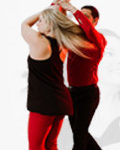Most dancers understand that they need to practice slowly in order to develop their control over a movement. Moving slowly gives you time to think about what you are going to do, to find muscles or positions that you aren’t used to using, and to check that your motion produces the result you expect.
Dancing west coast swing faster
However, most dancers don’t spend as much time practicing dancing fast. This is a missed opportunity because practicing fast gives a good reality check of how well you have mastered a skill. More importantly, the ability to dance fast comfortably means that you will be able to enjoy social dancing to a wider variety of songs. For competitors, practicing fast also reduces your chances of being caught off guard by an unusually fast song or being exhausted when the head judge calls for an extra song for your heat.
Your drill for dancing west coast swing faster
You can practice dancing faster when doing specific new skills—body movements, footwork elements, or musical interpretation. Or, you can choose to simply practice dancing to faster music in general in order to target your overall performance and endurance. Both are valid options: you just need to decide which you want to do when you start practicing.
The purpose of dancing to faster music is to stretch your abilities with the tempo of the music. So, select music that is within your stretch zone. Ideally, you should be able to execute your movements (or partnering/musicality skills) correctly about 60% of the time. If you fall below 50% correct execution, the music is too fast and you are encoding bad movements into your muscle memory. 60-80% success is a good learning zone: there are still plenty of opportunities for improvement, but you are training the correct version more often than not.
Once you are successfully executing the skill 9 out of every 10 times, find a song with a slightly higher tempo and continue pushing yourself.
If you want to be comfortable on the social or competition floor, you should practice above what you need to do. Right now, most music doesn’t go beyond 120bpm, although the occasional song will be in the high 120s. If you practice up to 130bpm, a 125bpm song will be easily within your capabilities. (If you are an advanced or higher level dancer, you may hear older songs that go even faster: Fever, Red Beans, etc. Practice accordingly!)



 Brian & Megan
Brian & Megan